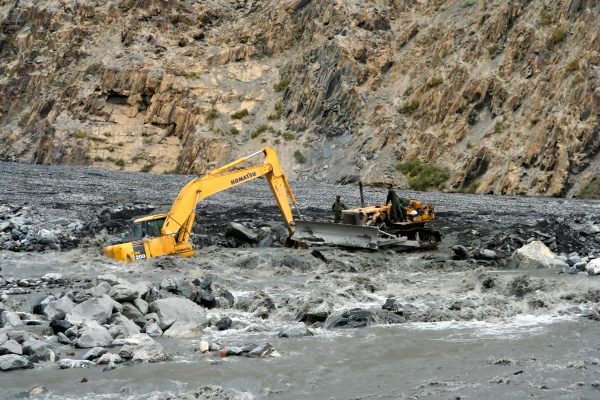By Kunwar Khuldune Shahid
Copyright thediplomat

As Prime Minister Shehbaz Sharif signed a historic defense pact with Saudi Crown Prince Mohammed Bin Salman in Riyadh on Wednesday, back home, Pakistan was reeling from the aftereffects of some of the worst flooding in the country’s history. The juxtaposition was inevitable, given Pakistan’s 20 percent increase in defense funding in July, in a budget where overall federal expenditure was slashed – just as floods were ravaging northern parts of the country. The destruction has left over 2 million homeless, more than a thousand dead, and a significant percentage of Pakistan’s population, 40 percent of whom live below the poverty line, fighting for survival. This year’s crisis comes three years after at least 1,700 were killed, more than 30 million people affected, and up to 10 million acres of agricultural land destroyed in the 2022 floods that caused damages exceeding $15 billion. Pakistan continues to struggle to raise funds for disaster management. Pakistan was listed as the most vulnerable country to environmental effects by the Climate Risk Index in 2022. The country experiences frequent floods, which this year were caused by excessive monsoon rains in both the northeastern and northwestern areas, as well as glaciers melting in the Gilgit-Baltistan region owing to rising temperatures. With over 13,000 glaciers, more than any place in the world outside the Earth’s polar regions, Pakistan is increasingly suffering from global warming. As glacial ice melts, flooding is further aggravated by construction activities close to rivers in the region. The infrastructure around the rivers, such as barrages, dams, bridges over rivers, and the encroachment of land for agriculture, has been a major cause of flood devastation. “We need a rethink on how we approach rivers. These floods were exacerbated by climate change; they weren’t caused by them,” environmental lawyer Ahmad Rafay Alam told The Diplomat. While the government has been urged to discourage the misuse of land, real estate developers have been a major culprit. Housing societies near the Ravi River, for instance, have been seen submerged in floodwaters this year. “If you want to build near a river, at least take some of the profits from your investments and put them into securing your properties,” said Alam. With some of the most powerful individuals and institutions in Pakistan involved in the real estate business, including the omnipotent military establishment, the government looks elsewhere to pin the blame, especially across the eastern border. Federal Minister of Planning, Development, and Special Initiatives Ahsan Iqbal last month accused New Delhi of “weaponizing water,” claiming that India “has caused wide-scale flooding in [Pakistan’s] Punjab.” Indeed, threats to drown or dry out Pakistan have been a part of the Indian government’s recent rhetoric, which has escalated since the two countries clashed this May in the deadliest fighting between the nuclear-armed rivals since the turn of the century. However, Pakistan’s flood crisis, as things stand, has very little to do with India. As per the 1960 Indus Waters Treaty, which the Indian government walked out of ahead of the May clashes, India can exclusively use the waters of three eastern rivers – the Sutlej, Beas, and Ravi – while Pakistan has the rights to the three western rivers – the Indus, Jhelum, and Chenab. New Delhi has allowance to use the western rivers’ waters up to a certain volume, and build small run-of-the-river dams. “None of the infrastructures on the western rivers [in India] is large or close enough to Pakistan to cause any significant dent in water flows. Dam managers exercised controlled releases to prevent the excess rainfall from raising storage levels in dams beyond critical levels,” said Alam. Disproportionate flooding wasn’t witnessed in Jhelum or the upper parts of the Indus, and when India released excessive water from the dams on the eastern rivers, not only did it inform Islamabad, but severe damage was caused in Indian territory as well, prompting criticism at home. “The exact degree to which these dam releases [in India] increased floodwaters in Pakistan’s Sutlej and Ravi may be determined, but I don’t think it was done to spite Pakistan at all,” added Alam. Maintaining a focus on the threat posed by India not only helps the military stake a claim on the national budgets, but it also deflects any attention from the misgovernance and misappropriation that is marring Pakistan’s fight against natural disasters. Being in a perpetual economic crisis means that Pakistan’s financial disparities are already prodigious. Still with a mere 1 percent of the federal budget allocated to disaster management, the country has kept itself underequipped. While international organizations, such as the Asian Development Bank, have provided support to local institutions such as the National Disaster Risk Management Fund (NDRMF), Pakistan’s institutional shortcomings, coupled with Western states gradually pulling out of their commitment to a global fight for climate change, have further intensified the challenge. “The West will help you as much as it is in their interest. Obviously, there are responsible governments that are not ready to provide their taxpayers’ money to help a country run by thieves. There are huge lobbies in the West that say that we should not help such irresponsible countries,” Pakistan’s former climate change secretary, Syed Abu Ahmad Akif, told The Diplomat. Akif maintained that, in its fight against natural disasters, Pakistan suffers from both a lack of funds and the misappropriation of what money there is, with the country ranking at 135 in a list of 180 countries on the Corruption Perception Index. He cited the example of the United Nations Development Program’s GLOF projects, designed to scale and counter glacial lake outburst floods (GLOF). “The GLOF-2 project was worth about $39 million,” Akif explained. “And as soon as the money came, first cars and jeeps were bought, offices were decorated, visits of officers were arranged, and then whatever money was left was spent on some projects.” Corruption is rampant in the funds that arrive from global organizations, but it is also a direct contributor to environmental degradation. As real estate ventures, especially linked with the military, often benefit from the skewed power structures in the country, even activities such as deforestation are exacerbated by Pakistan’s political and governance woes. Deforestation is a primary cause of flood devastation in Pakistan, especially in Khyber Pakhtunkhwa (KP) Province. Pakistan suffers 11,000 hectares of loss in total forest cover annually. Forest cover has reduced from 33 percent of the land area in 1947 to 5 percent today. Part of the problem is illegal loggers, who have long profited from smuggling timber. Locals have informed The Diplomat that not only has the government failed to crack down on what they dub the “timber mafia,” but there have been instances where entire patches of land have been cleared artificially and then their disappearance pinned on forest fires. “Certain groups have been allowed to chop off forests with impunity. In Swat and Mansehra, forest fires are systematically used by the timber mafia to make money, without any action or accountability on the part of the KP government,” said research analyst Saifullah Mahsud, the founder of FATA Research Centre. Locals further reveal that similar misappropriation is also prevalent in the tourism industry in the province, with construction taking place on river beds to cater to a high number of tourists in summer when water levels remain low. “The land is made available at cheap rates, and given the potential of flash floods in the area, the construction quality is significantly low. It is designed for certain sections to profit from the tourist season in KP,” Mahsud claimed. The Pakistan Tehreek-e-Insaf (PTI) – which remains at loggerheads with the military establishment over the fate of its incarcerated founder Imran Khan – has ruled over KP since 2013. For the party’s critics, the scale of deforestation and the embezzlement therein is an obvious negation of the PTI’s manifesto, which clamoured for policies to address corruption and climate change. “They came up with vows of a billion tree tsunami, and are now overseeing timber mafias. From politicians, to contractors, to the businesspersons, corruption has become a norm in KP, but the political leadership continues to chant slogans and vow reforms during disasters for public consumption,” maintained Mahsud. In Punjab and Sindh, meanwhile, similar allegations are levelled against the Pakistan Muslim League-Nawaz (PML-N) and the Pakistan People’s Party (PPP) respectively, the two parties that also lead the government alliance at the center. Misappropriation of funds and illicit support for mafias such as land grabbers or sugar cartels have long hindered developmental reforms. In Karachi and Lahore, the capitals of Sindh and Punjab, and the two largest cities in the country, flawed urban planning and misgovernance are often cited as major reasons behind mounting environmental challenges. Karachi, for instance suffers from inadequate drainage, and Lahore’s “haphazard” construction along waterways is a major reason why the city was inundated this summer with the worst flooding in almost four decades. “We cannot allow any commercial activity along these rivers and canals. Architecture cannot only be for aesthetics. We cannot just focus on making roads and highways. [Construction] must now cater to resilience, adaptation, and responsiveness,” said architect, urbanist, and sustainable development expert Imrana Tiwana to The Diplomat. Tiwana insisted that while urban planning needs massive reforms, city-level adjustments are not enough. Major changes are needed nationwide. “There needs to be a focused land use planning and zoning across the country. It is very easy to do this through AI-simulated modelling to predict where the hotspots are.” After this summer’s devastation, there are calls to upgrade the country’s urban planning manuals, build codes with flooding in mind, and readdress the expansion of larger cities that exacerbates urban flooding. Yet many argue that there are numerous plans already in place that have long awaited implementation. Each of Pakistan’s four provinces, along with the region of Gilgit-Baltistan and the country’s administered section of Kashmir, has its own environmental policy. Climate change is a subject for the provinces as per the Constitution, allowing provincial governments the right to allocate their resources to disaster relief accordingly. At the center, Pakistan adopted its first National Climate Change Policy in 2012, with its latest update coming in 2021. Pakistan also unveiled a National Adaptation Plan in 2023 designed to address nationwide climate risk and disaster management, spearheaded by the Ministry of Climate Change. Pakistan has also had a Federal Flood Commission (FFC) since 1977. But the lack of government focus has rendered these policies and institutions inconsequential. “If we have made these institutions, and we believe that they don’t serve the interests of the powers that be, or that it was a mistake to build them, then we might as well get rid of them,” said former FFC president Ahmad Kamal sarcastically, while speaking with The Diplomat. “The reason governments don’t want to spend any money on disaster relief and flood protection is because those investments aren’t as visible, whereas most infrastructure and construction can be utilized for political gains,” he added. Kamal underscored that despite a whole host of action plans to counter the effects of climate change, and the availability of disaster management strategies, Pakistan isn’t any closer to implementing them. Instead, it is largely relying on international funds to undo the damage already done. “The country needs a coordinated approach. Despite all plans and policies, most of the time we are in a reactive mode – we need to be proactive, starting with making institutions stronger,” he concluded. “Unfortunately, we don’t pay any attention to the institutions that can help us address environmental challenges, because our priorities lie elsewhere.” A major priority has been to sustain Pakistan as a security state, which has also been the solitary plan of action to attract any form of investment in the country. While agreements such as last week’s defense pact with Saudi Arabia continue to uphold Pakistan’s military utility for global powers, the perpetually flaunted narrative that the country is always facing a security threat in the region also ensures that the army remains the only institution whose well-being is safeguarded. Inflated defense budgets are anointed as critical to Pakistan’s survival. “Bad ecology today is a high security risk,” reminded Tiwana, the sustainable development expert. “Risk governance and risk-informed development are very important. Multilateralism needs to be looked at, and capacity building needs to be extended.” The dedication of energy and resources to maintaining an extortionate security apparatus, or to mafias and cartels that can benefit the political leadership, will do little to help Pakistan offer any resistance to natural catastrophes such as floods, the frequency and extent of which are ominously increasing. “If we continue just building overpasses and underpasses, subsidizing the sugar industry, and buying toys for boys [a euphemism for the army], nothing is going to change,” maintained environmental lawyer Alam.



